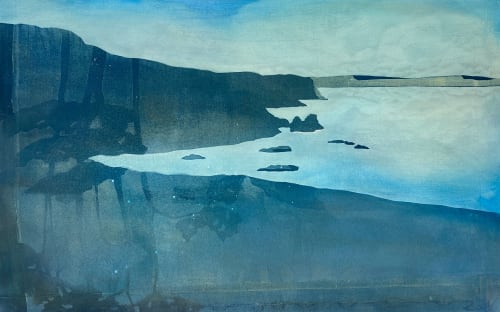In Harding’s works seemingly familiar scenes are distorted, their elements manipulated such that they cannot be pinpointed in reality. Instead, they exist hazily, some bleached by light and others cast in shadow. Based in North Cornwall the rugged coastline and big skies dominate.
Harding plays with perspective using a variety of techniques. Leaves and clouds, painted with photorealistic precision, sit over freely applied washes of paint. Translucent layers expose ghostly imprints that have seeped through the canvas from the other side. Key to their creation, the paintings have often lived many lives. The canvases are repeatedly reworked, sometimes over several years, and bear the scars of being layered with paint, stripped and scraped numerous times. Centuries of erosion and deposition that have formed, and continue to shape, the coastline are mirrored in this physical working and reworking of the surface. It is this process that gives the paintings their authenticity.
There are characteristics that root Harding’s practice in Romanticism and it is notable that she cites both Caspar David Friedrich (German, 1774-1840) and Gerhard Richter (German, 1932- ) as major influences on her work. A key protagonist of the Romanticism movement, Friedrich sought to demonstrate that nature can elicit an emotional response in its viewer. The idea that landscape painting can be subversive appeals strongly to Harding. Like Richter, who in the late 1960s blended hyper realistic elements of painting with the abstraction of landscape, her process relies heavily on the use of photography of her surrounding landscape and yet she does not seek to replicate real life. Instead, she looks to her photographs for reference, inspiration and reminders, selecting the elements that most appeal and disregarding those that do not.
Harding holds a BA in Fine Art from Ruskin School of Art, Oxford University (1991-94) and an MA in painting from Falmouth (2000-03).
